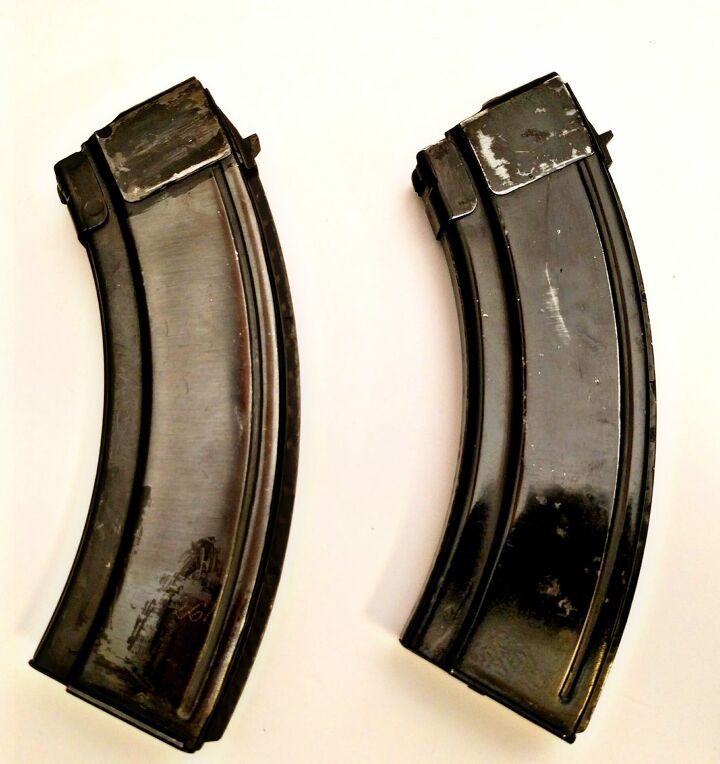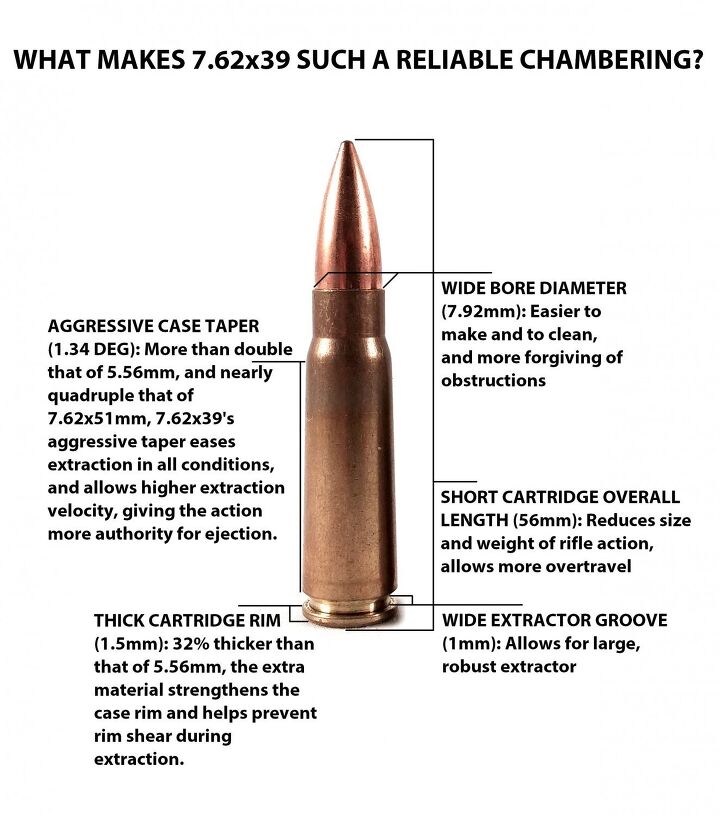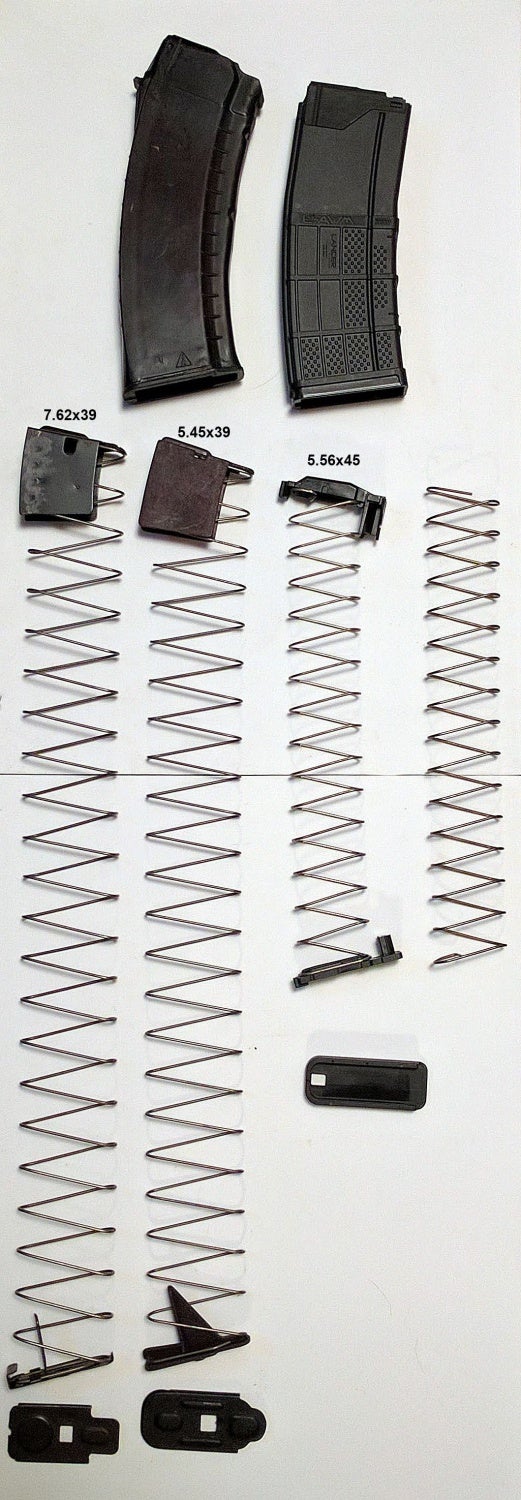Yesterday, we took a close look at the AK’s operating group, to enumerate the details that make this pattern such a dependable design. Today, we’re going to be looking at some of the other elements of the AK that make it so reliable, but first I want to clear up some confusion that arose in the comments section of the previous article, regarding what the term “anti-preengagement” refers to. Hopefully the video below will help:
In other words, anti-preengagement is just a mechanism that locks the bolt in the open position with the carrier during cycling, preventing it from rubbing against the receiver and generating friction.
Alright, now on to the rest:
2. Magazine and feedway design
Perhaps the single most critical item in a magazine-fed firearm system is the magazine itself. Without an effective, reliable magazine, a firearm will simply not feed properly, and a common (and essentially correct) estimate is that 95-99% of malfunctions experienced with a modern automatic firearm will be the fault of a bad magazine.
The AR-15 had to claw its way up to an excellent magazine design over decades, but Kalashnikov simply brute-forced the design of the magazines for his AK-47. The Kalashnikov magazine is a hugely overbuilt device that achieves reliability and longevity through sound design and sheer mass combined. Certainly, the Kalashnikov magazine is very well-engineered, but its most distinctive feature is its overbuiltness, especially when considering the original slab-sided pattern,

The original slab-sided magazines, shown here, are an exercise in excess. They are so ludicrously overbuilt that they can be used as hammers regularly and still function. This, perhaps more than anything, is the biggest reason for the AK-47’s reputation as a supremely reliable rifle, especially in peasant hands. Image source: Reader Brandon
The body of AK magazines is a fairly simple curve, but the feed tower is more noteworthy. Overbuilt like the rest of the magazine, the feed tower incorporates clever geometry that supports the magazine when locked in the gun, without requiring an AR-15 style mag well or a chute. Another important feature of the feed tower are the relatively long feed lips, which are long enough to control the round’s travel until its nose has entered the chamber of the barrel. This means that, unlike an AR-15, an AK-47 will be very, very unlikely to have a feeding problem where the round fishtails or yaws and fails to enter the chamber.
Aiding this straight shot to the chamber is the AK’s very clean feedway. Unlike an AR-15, which has to push its rounds over a ramped barrel extension and into the chamber, the AK has virtually nothing in between the round and the chamber itself. Also, the rounds do not have to climb to reach the chamber; the magazine positions them so that they are virtually in-line with it already. This extremely clean feedway design, combined with the feed lip arrangement helps ensure reliable, trouble-free feeding every time. It would be untrue to say that AK’s never had feeding problems, but with the way that the feed lips, feedway, and chamber geometry of the AK are designed, it’s very unlikely!
I want to mention two other things: First, the unrecognized advantages of rock-in/rock-out magazines. While straight-insert magazines like those of an AR-15 allow for faster reloading in ideal conditions, the AK’s rock and roll arrangement allows for substantially greater leverage when removing and inserting magazines into the gun. This means that magazines are much less likely to get so stuck that the user cannot remove them (although it is obviously still possible, especially if magazines are used that do not fit the rifle).
Second, I want to note a small virtue of rifles – like the AK – that do not feature a last round automatic bolt hold open device. While I consider bolt hold opens to be a good idea, it is certainly worth mentioning that a rifle that does not have one will expose its action to debris for the minimum amount of time possible. In extreme conditions, such as sandstorms, the fact that the bolt group does not remain open during loading, allowing dust and debris to enter the action, may be a substantial boon to the rifle’s performance in these circumstances. Although, as I stated before, I consider last round bolt hold opens to be a good thing, the AK’s lack of one helps illustrate the kind of extreme compromises that might need to be made to achieve peerless reliability.
3. Ammunition and chamber design
It’s no secret that 7.62x39mm is one of the most designer-friendly centerfire rifle cartridges ever designed. Extremely well-tapered, with a wide bore and low thermal load, this rifle cartridge is optimized for reliable weapon function, not performance. Briefly, let’s take a closer look:
The 7.62x39mm’s successor, the 5.45x39mm, relaxes some of these features (specifically, smaller bore diameter, less ludicrous but still ample case taper), but still retains the thick rim, wide extractor groove, and considerable case taper.
No discussion about the AK’s chamber and ammunition would be complete without mentioning that the Kalashnikov was from the start an all-chromed gun, with chrome-lined chamber, barrel, piston and oprod, and in some models, even the entire bolt carrier. Chroming is essential in areas with high moisture levels (such as Russia in the summer, or Indochina), and a lack of it led to the greater part of the American M16 rifle’s problems during the first years of Vietnam. The fact that the most essential parts of Kalashnikovs were from the outset hard chromed no doubt contributed significantly to its reputation for dead nuts reliability.
4. Spring design
Perhaps the most overlooked basic element of firearms engineering are the humble springs. For modern “self-powered” (i.e., driven by the power of the round itself, as opposed to electrically driven) firearms, it is the springs that make the whole weapon possible. What we see with the AK’s springs is some of the most solid engineering there is to see in the world of modern automatic small arms.
The springs on an AK rifle are – each of them – designed to provide ample, even power throughout their strokes. This is done by ensuring the springs are never either fully compressed or fully extended during the normal operation of the firearm. The action spring of the AK, for example, does not quite compress completely, but instead the bolt group bottoms out against the rear of the receiver. This is bad for the rifle’s recoil characteristics, but good for the spring, letting it last longer without wearing out. Perhaps more importantly, though, then AK’s action spring never comes close to achieving its full extension, meaning that even when the bolt is completely locked and in battery the spring is still exerting a great deal of force against it. This means that in situations such as when the chamber is fouled, or the cartridge has been especially tough to strip from the magazine and eaten up a lot of the driving energy of the action, the bolt group will always have plenty of energy to close and lock. You can see the difference this makes at home, if you have examples of an AK and almost any other semi-automatic rifle handy: Load a round into each chamber and close the bolt, then pop the bolt open slightly. Many other weapons will stay out of battery like this, but an AK – provided its action spring is not worn out – will always close and lock even from a dead start with zero forward momentum.
The magazine springs give another good example of the dramatic over-engineering of the Kalashnikov spring system. Compared to its counterparts, the springs used in AK magazines are extremely long, meaning they too provide more consistent, constant force on the round stack, ensuring the first round rises quickly into position just the same as the last. Compared below is an AK-74 magazine on the left, and a Lancer AWM magazine on the right, with a USGI spring. Note that the AK-74’s spring is nearly twice as long!
This section wouldn’t be complete without mentioning the AK’s semi-famous braided hammer spring. A braided spring was a wise choice here, as the higher impact resistance of a braided spring allows for an even more violent (and therefore reliable) hammer action, ensuring ignition of even bombproof rifle primers. Like the rest of the springs in the rifle, the hammer spring too is never allowed to reach full extension or compression.
5. Fire control group design
Which brings us to the AK’s fire control group. In many ways, this is a study in orthodoxy, as the AK uses the same Browning double-hook trigger design that dates back to the old Auto-5 shotgun. However, coupled this this simple, reliable Browning trigger system is Kalashnikov’s own automatic sear and rate reducer, which not only allows fire control of all modes to occur from a single lever, but also reduces the automatic fire rate down to about 700 rounds per minute. You can see how this trigger group works in the video below:
Simpler automatic trigger groups have certainly been designed, but Kalashnikov’s is still an excellent design that builds on a proven, simple mechanism.
One final note about the fire control group is how the fire control chamber is designed. In an AR-15, the fire control group occupies a small space, with very little room for additional debris. In the unlikely event that grit does reach the fire control group, there is very little space for it to go but into the mechanism itself. However, AKs have a much roomier fire control housing that makes them substantially more resistant to invading debris and grit. They are, like any mechanical device, not immune to debris ingress, but the additional space substantially lessens the chance of malfunction versus other designs that have tightly packed trigger groups. It also, as a final point, makes this area substantially easier for the user to clean without disassembling it.
6. The Details
We will conclude by covering some of the small details about the AK that readers might not have considered as lending to its reliability. One of the major design drivers for Kalashnikov must have been performance in cold conditions (it is unthinkable that this wasn’t, given the Russian climate), and we see a number of features that appear to be compromises to this end. The large and much-lamented safety switch, which slows and loudens making the rifle ready to fire, is in freezing conditions a boon. The switch’s long length gives the user substantial leverage to break it free of ice, snow, and mud, where the short, convenient safety lever of another rifle might simply be frozen up entirely.
Likewise, the lever-type magazine release is far more resistant to freezing conditions than a button-type release, which, coupled with the aforementioned leverage advantage of rock-in magazines, gives the Kalashnikov user a substantial advantage in cold weather when it comes to reloading. You can get a further sense of this by watching this video of cold weather rifle testing by the Military Arms Channel.
Finally, let’s not forget the simple effectiveness of a fixed, right-side charging handle. For most people, their dominant arm (most often the right) is the stronger of the two; this is perhaps one reason why bolt actions have their bolt handles on the dominant side, rather than the non-dominant. So, while the right-hand reciprocating charging handle of an AK is not the most ideal setup for 3-gun gaming, it is perhaps the ideal set up for malfunction clearance and troubleshooting, especially in bad weather. It should not be forgotten than just as important as – if not more than! – how infrequently a rifle has a problem is how easy it is to clear that problem and get the rifle back into action. Charging handle placement is perhaps too subjective to draw a clear conclusion here, but I encourage my readers at home to try this: Take your rifle, assuming it has a charging handle on one side or the other, and try charging it with the butt against your thigh. Then, flip it upside down so that the handle faces the other way, and try it that way with the opposite hand. Which did you feel was better? Why? Please, let me know in the comments!
 Your Privacy Choices
Your Privacy Choices


